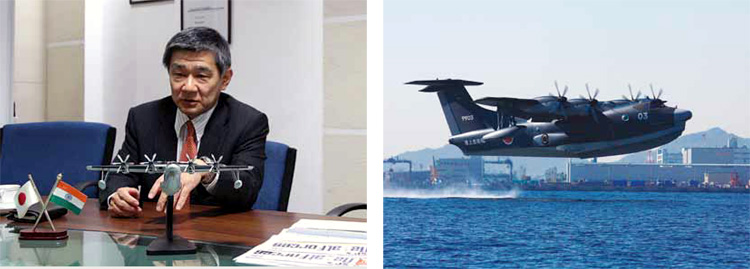- Prime Minister Narendra Modi inaugurates Aero India 2023 in Bengaluru; Releases Commemorative Stamp
- Defence Secretary meets delegations from Saudi Arabia, USA and Oman on the sidelines of Aero India 2023
- Foreign Ministers of 32 countries to attend Aero India 2023
- Embraer showcases the C-390 Millennium at Aero India 2023
ShinMaywa’s US-2 Top on India’s Agenda
Media reports indicate that India and Japan are discussing signing an Inter-Governmental Agreement (IGA) to cooperate on ShinMaywa’s offering of utility seaplane- mark II (US-2), similar to the IGA it has entered with Russia to co-develop a fifth-generation fighter. An IGA recognises the strategic importance of a procurement programme, and takes it out of the purview of the restrictive Defence Procurement Procedure.
India and Japan formed a Joint Working Group to explore modality for the cooperation on the US-2 amphibian aircraft. Kanji Ishimaru, the Managing Director of ShinMaywa Industries India Pvt Ltd and Director ShinMaywa Industries Ltd, Japan, said that the US-2 is a unique aircraft and the only ‘in-service’ open sea capable amphibian aircraft with state-of-the-art equipment.

SP’s ShowNews (SP’s): Could you update on the proposal for requirement of an amphibious aircraft for the Indian Navy?
Kanji Ishimaru (Ishimaru): Since the request for information (RFI) was issued and we responded, ShinMaywa has commenced the process of intraocular pressure (IOP) surveillance to finalise our potential IOP partner. We have also had many meetings with Government of India officials, Indian Navy, Indian Air Force and the Indian Coast Guard. Our experience has been very good till now and there is clearly a very good appreciation of the US-2 unique capabilities and how usefully it can conduct a variety of difficult missions. The US-2 features of military certification for sustained operations in Sea State 5, shortest take-off and landing distances, very long-range operations, good payload and high transit speeds are unmatched in the world. Combine this with Japanese technology, customer support and quality standards, we know that the US-2 is second to none.
SP’s: Subsequent to the visit of the Indian Prime Minister Dr. Manmohan Singh last year to Japan, a Joint Working Group was set up to work out modalities for induction of the amphibious aircraft. Could you indicate the progress made by the group?
Ishimaru: The JWG has been established and preliminary meeting of the subcommittee was held in November 2013. Therefore, we expect that the progress of JWG would be discussed as part of the agenda during the next summit meeting. ShinMaywa Japan is also part of the JWG.
SP’s: What kind of transfer of technology (ToT) are you envisaging to accomplish with this contract? Would it help build the Indian aviation industry and bring in capabilities that the nation does not have as yet?
Ishimaru: The Indian aviation private sector doesn’t have enough capability and experience at the present moment in aircraft manufacturing. So we have to really partner with Indian industry to build the required capability, develop the right skill sets, imbibe highest quality and work ethics and provide mentoring to our IOP to become a world-class company. Especially, for an aircraft as complicated as the US-2, it might take us a little while and the process has to be gradual but we are fully confident that if we have a chance we can help to transform the Indian aircraft industry just as Suzuki did to the automobile sector. We are also looking at maintenance, repair and overhaul for the aircraft in India, foreign direct investment and sourcing from a large number of small and medium enterprises (SMEs) and in addition, we also have an extremely interesting plan towards creating an impact towards genuine capability building in the country in aeronautical engineering. Discussions are on with certain institutions regarding the same. Our plans are not ‘one-off sale’ but we are completely committed to partner with India for a long-term high-technology relationship.
SP’s: Could you highlight some of the features of US-2i and how it fits the requirement of the Indian Navy?
Ishimaru: The modern amphibious aircraft is a veritable force multiplier since they fulfil a multitude of missions in a single platform. Unlike helicopters and aircraft, amphibious aircraft can land at the location and enforce both the will and the law of the country and thus are a platform of choice for all benign and constabulary missions of navies. The US-2 is a unique aircraft and the only ‘in-service’ open sea capable amphibian aircraft with state-of-the-art equipment, very rough sea operations and riverine/lake landing capability, short take-off and landing features, long endurance and extended radius of operations with large payload capacity. With such unique features, we consider the US-2 to be the most effective platform to carry out benign missions such as search and rescue, CASEVAC, humanitarian relief and disaster management, and ‘constabulary’ missions such as extended exclusive economic zone surveillance and maritime domain awareness missions of the Indian Navy to maintain effective and economic good order at sea. In addition, the US-2 is extremely useful for strengthening the safety and security of sea lines of communication, long-range fleet support and island/ offshore assets (both overseas and coastal) support functions. These missions when combined in a single multi-modal platform such as the US-2 can achieve for India a resounding success in public diplomacy and in earning the precious goodwill of nations of the Indian Ocean region commensurate with its identity as a responsible rising power.





